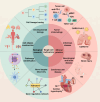Single-cell sequencing to multi-omics: technologies and applications
- PMID: 39334490
- PMCID: PMC11438019
- DOI: 10.1186/s40364-024-00643-4
Single-cell sequencing to multi-omics: technologies and applications
Abstract
Cells, as the fundamental units of life, contain multidimensional spatiotemporal information. Single-cell RNA sequencing (scRNA-seq) is revolutionizing biomedical science by analyzing cellular state and intercellular heterogeneity. Undoubtedly, single-cell transcriptomics has emerged as one of the most vibrant research fields today. With the optimization and innovation of single-cell sequencing technologies, the intricate multidimensional details concealed within cells are gradually unveiled. The combination of scRNA-seq and other multi-omics is at the forefront of the single-cell field. This involves simultaneously measuring various omics data within individual cells, expanding our understanding across a broader spectrum of dimensions. Single-cell multi-omics precisely captures the multidimensional aspects of single-cell transcriptomes, immune repertoire, spatial information, temporal information, epitopes, and other omics in diverse spatiotemporal contexts. In addition to depicting the cell atlas of normal or diseased tissues, it also provides a cornerstone for studying cell differentiation and development patterns, disease heterogeneity, drug resistance mechanisms, and treatment strategies. Herein, we review traditional single-cell sequencing technologies and outline the latest advancements in single-cell multi-omics. We summarize the current status and challenges of applying single-cell multi-omics technologies to biological research and clinical applications. Finally, we discuss the limitations and challenges of single-cell multi-omics and potential strategies to address them.
Keywords: Computational biology; Metabolome; Microbiome; Proteomics; Single-cell multi-omics; Spatial transcriptomics; scBCR-seq; scRNA-seq; scTCR-seq.
© 2024. The Author(s).
Conflict of interest statement
The authors declare no competing interests.
The authors declare no conflicts of interest.
Figures




Similar articles
-
DEMOC: a deep embedded multi-omics learning approach for clustering single-cell CITE-seq data.Brief Bioinform. 2022 Sep 20;23(5):bbac347. doi: 10.1093/bib/bbac347. Brief Bioinform. 2022. PMID: 36047285
-
The technological landscape and applications of single-cell multi-omics.Nat Rev Mol Cell Biol. 2023 Oct;24(10):695-713. doi: 10.1038/s41580-023-00615-w. Epub 2023 Jun 6. Nat Rev Mol Cell Biol. 2023. PMID: 37280296 Free PMC article. Review.
-
Single-cell multi-omics in the study of digestive system cancers.Comput Struct Biotechnol J. 2023 Dec 12;23:431-445. doi: 10.1016/j.csbj.2023.12.007. eCollection 2024 Dec. Comput Struct Biotechnol J. 2023. PMID: 38223343 Free PMC article. Review.
-
SECANT: a biology-guided semi-supervised method for clustering, classification, and annotation of single-cell multi-omics.PNAS Nexus. 2022 Aug 19;1(4):pgac165. doi: 10.1093/pnasnexus/pgac165. eCollection 2022 Sep. PNAS Nexus. 2022. PMID: 36157595 Free PMC article.
-
Multi-omics analysis in developmental bone biology.Jpn Dent Sci Rev. 2023 Dec;59:412-420. doi: 10.1016/j.jdsr.2023.10.006. Epub 2023 Nov 10. Jpn Dent Sci Rev. 2023. PMID: 38022387 Free PMC article. Review.
Cited by
-
Mendelian Randomization Combined with Single-Cell Transcriptome Analysis Reveals the Role of the Key Gene PCLAF in the Pathogenesis of Atopic Dermatitis.Clin Cosmet Investig Dermatol. 2025 Apr 8;18:867-882. doi: 10.2147/CCID.S506139. eCollection 2025. Clin Cosmet Investig Dermatol. 2025. PMID: 40225314 Free PMC article.
-
Tumor-Associated Macrophages: Polarization, Immunoregulation, and Immunotherapy.Cells. 2025 May 19;14(10):741. doi: 10.3390/cells14100741. Cells. 2025. PMID: 40422244 Free PMC article. Review.
-
Illuminating diabetes via multi-omics: Unraveling disease mechanisms and advancing personalized therapy.World J Diabetes. 2025 Jul 15;16(7):106218. doi: 10.4239/wjd.v16.i7.106218. World J Diabetes. 2025. PMID: 40697608 Free PMC article. Review.
-
Impact of Heat Stress on Ovarian Function and circRNA Expression in Hu Sheep.Animals (Basel). 2025 Jul 12;15(14):2063. doi: 10.3390/ani15142063. Animals (Basel). 2025. PMID: 40723526 Free PMC article.
-
Diagnostics and Therapy for Malignant Tumors.Biomedicines. 2024 Nov 21;12(12):2659. doi: 10.3390/biomedicines12122659. Biomedicines. 2024. PMID: 39767566 Free PMC article. Review.
References
-
- Tang F, Barbacioru C, Wang Y, Nordman E, Lee C, Xu N, Wang X, Bodeau J, Tuch BB, Siddiqui A, et al. mRNA-Seq whole-transcriptome analysis of a single cell. Nat Methods. 2009;6:377–82. - PubMed
-
- Hashimshony T, Wagner F, Sher N, Yanai I. CEL-Seq: single-cell RNA-Seq by multiplexed linear amplification. Cell Rep. 2012;2:666–73. - PubMed
Publication types
Grants and funding
LinkOut - more resources
Full Text Sources
Other Literature Sources

